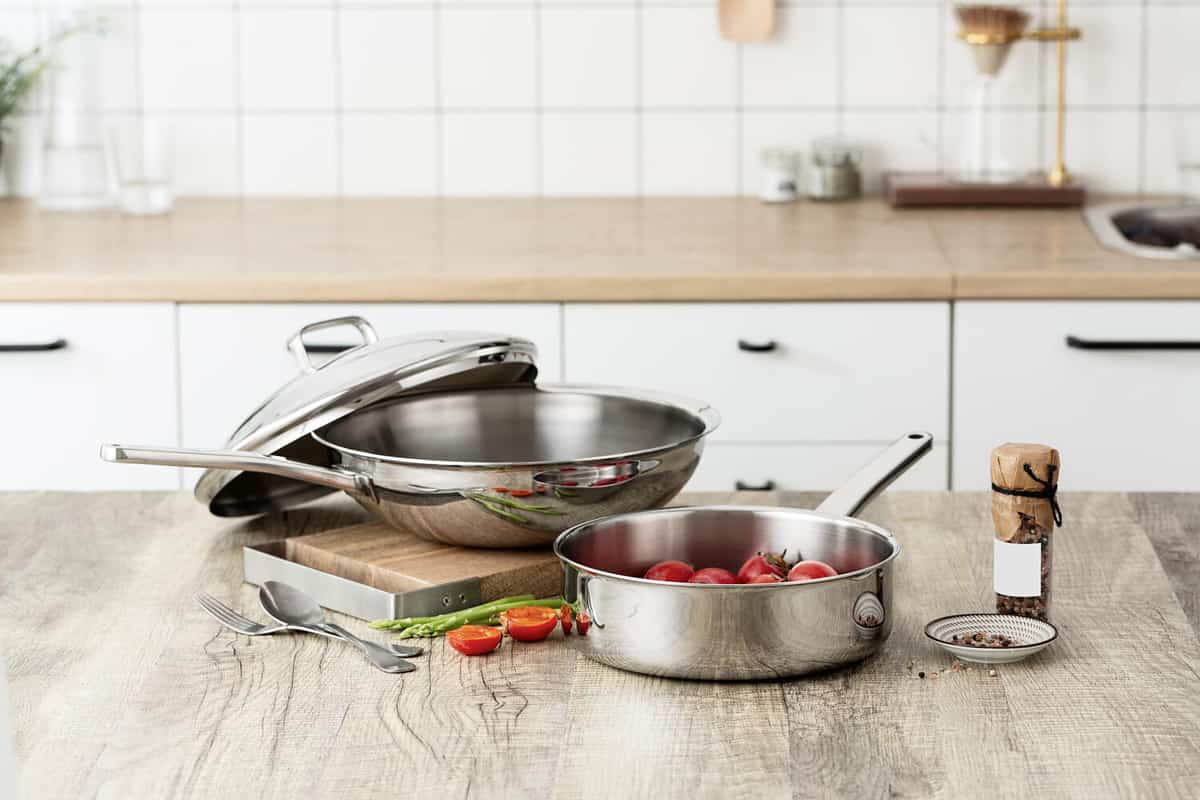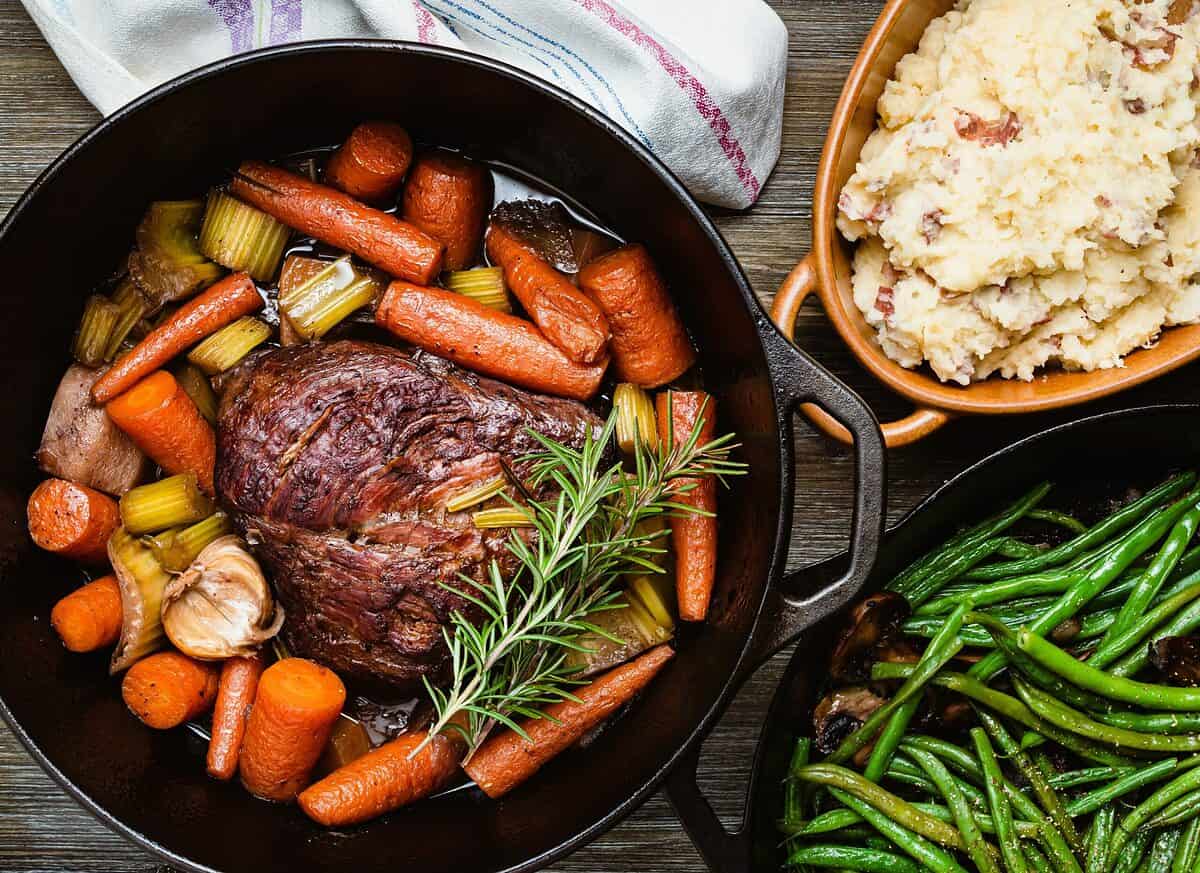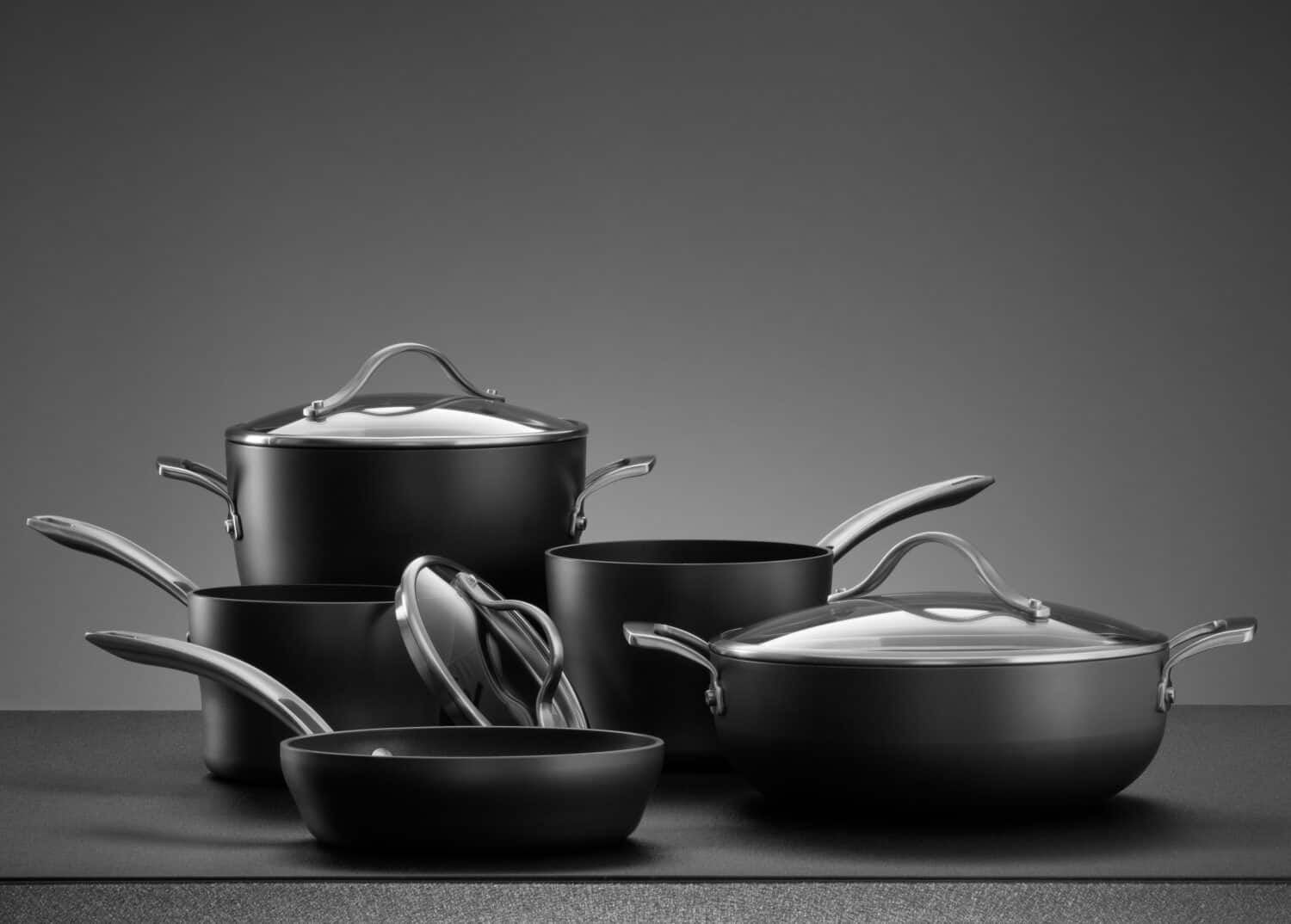There are numerous qualities that can help you determine the best cookware for your kitchen. While some of the most durable types of cookware, like stainless steel or cast iron, aren’t naturally non-stick, non-stick cookware can make cooking more convenient. If you’re looking into pots or pans that won’t stick, you might consider the difference between nonstick vs. enamel cookware.
The main difference between enamel and nonstick cookware is the type of nonstick coating. Enameled cookware is environmentally friendly and free of toxins or harmful chemicals. Nonstick cookware, on the other hand, generally refers to cookware with Teflon coating. This type of coating is made from synthetic materials and is not biodegradable.
If you’re looking for the most durable and efficient cookware for your kitchen, nonstick and enamel cookware can be great options. Keep reading to find out the difference between them and which one is the better choice for your kitchen.

Cookware with nonstick properties is often more convenient than other types.
©mirageart/Shutterstock.com
Nonstick vs. Enamel: What Is the Difference?
Nonstick properties are a non-negotiable for many people when choosing a new pot or pan. While cookware like cast iron or fully clad stainless steel is not naturally non-stick, those with some experience in the kitchen know that seasoning these types of cookware creates a nonstick cooking surface.
However, if you’re looking for something that doesn’t require seasoning, you might opt for a skillet with a nonstick coating. When comparing nonstick cookware vs. enameled, the names refer specifically to the coating on the cookware, not necessarily the materials used to make the cookware.
For example, enameled cookware could represent a variety of types. Typically, cast iron or steel cookware are the ones that come with an enameled coating. On the other hand, nonstick generally refers to cookware with a Teflon coating, although pots or pans with a ceramic coating might have nonstick in the name as well.
The biggest difference between nonstick and enamel is the type of coating. While enamel coating is eco-friendly, nonstick coating like Teflon includes synthetic ingredients. Many have raised concerns about the safety of Teflon coating over the years.
In the past, Teflon coating used a material called PFOA that wasn’t considered safe, but this material has since been removed from the manufacturing process. Enamel cookware, like enameled cast iron, is made by combining powdered glass with cast iron cookware. The glass fuses with the cast iron when heated, creating a protective layer that makes the cooking surface nonstick and prevents iron from seeping into your food.
Main Differences Between Nonstick vs. Enamel
Choosing between nonstick and enamel can be challenging, especially if you’re looking for the most affordable and convenient cookware. Here’s a look at the main differences between them:
- Enamel cookware is eco-friendly
If one of your concerns is safety or how environmentally friendly your cookware is, enameled cookware is a better choice. While typical nonstick coating includes synthetic materials that are not biodegradable, the enameled coating is made of powdered glass. This creates a nonstick surface when combined with the metal in the cookware. - Nonstick coating can peel off over time
While a quality nonstick pan should last you between 3-5 years, it can chip or peel over time. Once the nonstick coating on the pan is no longer effective, you’ll have to replace the entire pot or pan. It can also be a safety concern when the coating starts to peel off since pieces of it might get into your food. While Teflon claims ingesting these small pieces is harmless, you’ll want to replace your cookware if the coating is peeling off. - Enamel coating is more durable
One of the most popular types of enameled cookware is enameled cast iron. Cast iron cookware on its own is nearly indestructible. While the enamel coating can crack or break if you expose it to drastic temperatures, it will be more durable than nonstick as long as you take care of it.
What Is Nonstick Cookware?
Nonstick cookware is any kind of cookware with a nonstick coating, which is usually Teflon coating. There have been concerns over the years about the safety of this coating, but as technology has improved, so has the safety of nonstick cookware.
When deciding between nonstick and other types of pans, nonstick cookware can make your life a lot easier in the kitchen. This is especially true when it comes to cooking things like eggs or pancakes.
If a pot or pan is labeled as nonstick, this is often an umbrella term for a variety of cookware. For example, while Telfon is the most popular type of nonstick coating, ceramic cookware is also a nonstick option.
Additionally, materials such as stainless steel or cast iron are not naturally nonstick, but you can season them to create a nonstick cooking surface. However, when you purchase stainless steel or cast iron without a nonstick coating, you won't see nonstick in the name.
What type of cookware is nonstick?
The best part about nonstick is it's easy to use and low-maintenance. Unlike longer-lasting cookware such as cast iron, nonstick doesn’t require any seasoning and it’s simple to clean.
Nonstick cookware can refer to a variety of cookware types. Skillets or pots made out of aluminum, stainless steel, or ceramic can be labeled as nonstick. What designates them as nonstick is the nonstick coating on the cooking surface.
What Is Enamel Cookware?
Enamel cookware, also known as enameled cookware, is a type of cookware with an enamel-based coating. While there are various materials that can be enameled cookware, it's usually cast iron or a type of steel. The enamel part refers to the coating on the cookware, not the material itself.
There are a variety of types of enameled cookware, but the most common types are Dutch ovens and skillets. You might also find enamel baking dishes and other types of dishes.
What Is the Purpose of Enameled Cookware?
There are many benefits to purchasing enameled cookware, but one of the main benefits is how low-maintenance it is. For example, cast iron by itself needs to be seasoned to provide a nonstick surface. Enameled cast iron doesn’t require the same type of seasoning.
The enamel coating also provides a protective layer that prevents materials like cast iron from being reactive. When you add acidic ingredients to a reactive pot or pan, atoms of metal are transferred into your food. This can give your food a metallic taste, but the enamel coating prevents this reaction from happening.
Like nonstick cookware, the enamel cookware also creates a nonstick cooking surface. Many choose this type of nonstick cookware compared to cookware with Teflon coating since Teflon contains synthetic ingredients.
Enamel is a safer alternative to nonstick coating with Teflon. Additionally, you’re not supposed to use cookware with Teflon coating over 500 degrees since cooking above this temperature can lead to toxic fumes that may make you sick.

Enameled cast iron is a durable choice to add to your kitchen set.
©Nadia Nice/Shutterstock.com
Which Is More Durable: Nonstick or Enamel?
Stickiness is only one of the qualities you might look for when comparing types of cookware. Durability is also an important factor to consider. Like any investment, you may have considered how long the cookware will last you before purchasing a new set.
Durability is actually one of the cons for both nonstick and enameled cookware since they are prone to scratching or chipping. With Teflon, the coating is prone to chipping or peeling off over time.
With enameled coating, you don’t have to worry about it chipping or peeling, but it can crack when exposed to drastic temperatures. Nonstick and enameled cookware typically last between 3-5 years. Compared to cast iron and fully clad stainless steel cookware that can last decades, the life expectancy of these is pretty short. When comparing the two, however, enameled cookware is more durable than nonstick cookware.
Which Costs More: Nonstick or Enamel Cookware?
Another factor to consider when purchasing a new set of pots or pans is the cost. Nonstick cookware is the most affordable cookware on the market. Keep in mind though that the brand and quality will impact the price.
Enameled cookware is going to cost more than nonstick, but you’re often getting a much higher quality product. An enameled cast iron skillet or Dutch oven offers the many benefits of cast iron with the convenience of a nonstick pot. Typically, nonstick cookware made with aluminum isn’t going to last as long as enameled cookware.
Should You Choose Nonstick or Enamel Cookware?
Like any type of kitchen tool, there are pros and cons to both nonstick and enameled cookware. When it comes down to it, enameled cookware is better quality cookware and has more versatility in the kitchen.
While enameled cookware is at risk of cracking, if you take good care of it, it will last longer than nonstick coating with Teflon coating Additionally, enameled cookware is more eco-friendly and lacks the kind of synthetic ingredients used in many nonstick coatings.
If you’re looking for something that’s simple but also versatile in the kitchen, enamel may be the right fit for you.
The image featured at the top of this post is ©Ersler Dmitry/Shutterstock.com
